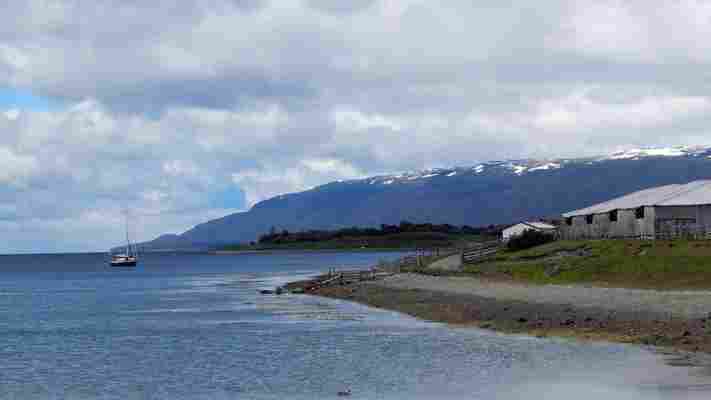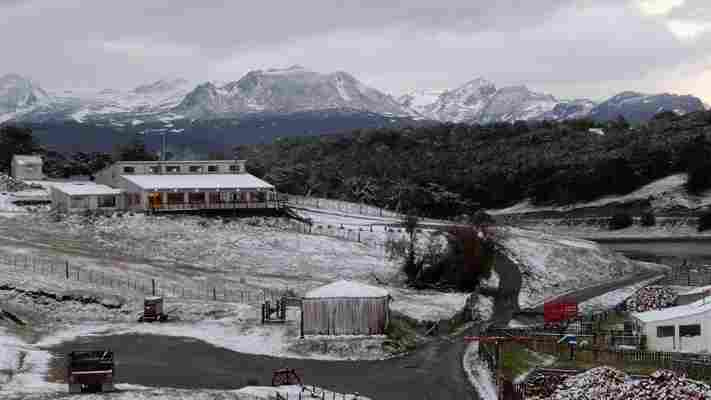Article continues below
Ushuaia, the southernmost city on Earth, is filled with signs proclaiming ‘El fin del mundo’ (The end of the world). The slogan adorns hotels, restaurants and shops, a local newspaper, the railway line and even a tango club.
It’s a boast, though, rather than a warning: the capital of Argentine Tierra del Fuego is the closest city to Antarctica, which lies just 1,000km to the south. To put that in context, Buenos Aires is more than 3,000km north. Although the city suffers bitter winters and was once home to a brutal penal colony nicknamed the ‘Siberia of the South’, Ushuaia is now a touristy, rapidly-modernising and rather comfortable city. To really experience Tierra del Fuego’s inhospitable remoteness, you have to travel 60km east, to the oldest ranch in the region.

Argentine Tierra del Fuego is only 1,000km north of Antarctica (Credit: Shafik Meghji)
You may also be interested in: • The US' little-known geographic oddity • A Unesco site that's almost unreachable • Where to drink the world's purest water
Located on a peninsula jutting out into the gunboat-grey Beagle Channel, Estancia Harberton was founded in 1886 by British missionary Thomas Bridges. He’d first visited Tierra del Fuego 22 years earlier, later setting up an Anglican mission in Ushuaia Bay, around which the modern city now stands. Named after the Devon village Bridges’ wife grew up in, Harberton spans more than 200 sq km of mountains, lakes, forests and islands.
Today the homestead looks much as it did in the 1880s: a neat cluster of whitewashed, red-roofed buildings set on a sheltered bay, flanked by green hills and jagged, snow-streaked Andean peaks. Bridges became an Argentine citizen, and he and Harberton played a major role in the history of Tierra del Fuego, providing sustenance for sailors shipwrecked off Cape Horn; support for scientists, explorers and settlers; and sanctuary for indigenous people. Still owned by descendants of the missionary, the ranch offers travellers a striking insight into life at the end of the world.

Estancia Harberton looks like an English country cottage, except for the giant whale jaw over the gate (Credit: Shafik Meghji)
On a bright winter morning, I was shown around by Juan Balda, a young, fast-talking guide. We started in a neatly-tended garden filled with roses, pine and apple trees, Scotch broom and London pride. It reminded me of an English country cottage – at least until I noticed the giant whale jaw arching over the gate. Tierra del Fuego was once the haunt of whalers, Balda told me, but these bones came from a carcass that washed up on a nearby beach.
The Bridges family survived thanks to a prodigious work ethic, a bloody-minded determination and the support and expertise of local indigenous people
The early years at Harberton were brutal. There was a series of severe winters – temperatures can plunge below -20C in Tierra del Fuego – and backbreaking labour was needed to tame the land. Provisions were expensive and hard to obtain; there were periodic outbreaks of typhoid and other diseases; and treacherous conditions in the Beagle Channel meant the estancia was essentially cut off from the rest of the world for long stretches, Balda said. But the Bridges family survived, and slowly prospered, thanks to a prodigious work ethic, a bloody-minded determination, and – not least – the support and expertise of local indigenous people.
Harberton was a working sheep ranch until the mid-1990s, when falling wool prices, poaching, wild dog attacks and a particularly harsh winter that wiped out 80% of the livestock prompted the move into tourism. The estancia was named a National Historic Monument in 1999, and the old shearing sheds, sawmill, workshops and cattle pens are evocative testaments to its farming heritage, housing an aged tractor, some vicious-looking circular saws and a pair of stuffed condors.

The Bridges family survived brutal conditions at Harberton, including temperatures that could plunge below -20C (Credit: Shafik Meghji)
Balda and I climbed a low hill to the family cemetery and a small nature reserve, the latter the first of its kind in Tierra del Fuego. A grey fox scurried away at our approach and a flock of upland geese passed overhead. Among the native trees and plants were two reconstructed wooden shelters once used by the Yámana people, one of the largest indigenous groups in Tierra del Fuego when Harberton was founded. Over the following decades, however, the region’s original inhabitants were forcibly displaced by waves of Europeans – many of them British – who set up vast sheep ranches and gold mines. “In the 1880s, there were around 10,000 indigenous people in Tierra del Fuego,” Balda said. “But they faced retribution for hunting sheep, and were hunted by lots of the estancia owners.”
Many were killed by bounty hunters, who were only paid after showing severed ears, hands or even a head as proof of their work. Others were forcibly relocated to Christian missions. “Diseases like measles and smallpox, which came with the settlers, killed huge numbers. Most of them were wiped out,” Balda told me.
Although Thomas Bridges arrived in the region to proselytize, he also studied the languages and cultures of the indigenous groups and wrote the first Yámana-English dictionary. His son, Lucas, continued in the same vein, learning the Yámana and Ona tongues, becoming the first European to be made a ‘blood brother’ of the Selk’nam people, and providing sanctuary for indigenous people seeking to preserve their traditional way of life. He wrote about his experiences in the 1948 classic The Uttermost Part of the Earth , which is both a story of adventure and a poignant documentation of cultures on the brink of destruction.
Harberton is now home to 3,000 breeding pairs of Magellanic penguins (Credit: Shafik Meghji)
While Harberton is rich in history, most travellers today come to see its penguins. Isla Martillo, one of several small islands belonging to the estancia, was originally used for grazing, but when the sheep were moved away, Magellanic penguins started to arrive. Their colony steadily grew, and there are now more than 3,000 breeding pairs as well as smaller numbers of gentoo and king penguins.
Welcome to the backside of the world
During the choppy 15-minute crossing to Isla Martillo, the weather turned dramatically, the crisp sunshine replaced by menacing grey skies. The temperature plunged well below zero, and gale-force winds whipped up stinging flurries of snow. It was a struggle to stay on my feet, but the skipper, clad in goggles and thick waterproofs, just grinned: “Welcome to the backside of the world,” he said.
The penguins, however, seemed perfectly at ease in the conditions. Some tended to fluffy black chicks while others incubated eggs. Their chorus of hoots – to guide mates back to the nests – was interrupted periodically by surprisingly loud sneezes, as they expelled salt ingested during their fishing trips. Although the birds looked amiable, the skipper warned me not to go near them. “They may seem cute but they have surprisingly sharp beaks and will swipe at you if you get too close,” he said.
A working ranch until the mid-1990s, Harberton is now a National Historic Monument (Credit: Matthias Breiter/Design Pics/Getty Images)
As enjoyable it as was to walk amongst the penguins, it was something of a relief to get back to the mainland and the warmth of the tea-room. After thawing out my numbed fingers and toes, I chatted with Abby Goodall, the great-great-granddaughter of Thomas Bridges. “I’m only here because of The Uttermost Part of the Earth,” she told me. In the 1960s, her mother, the American botanist Natalie Prosser, was travelling and teaching in Argentina, but after reading the book she decided to travel down to Harberton.
Prosser went on to found the estancia’s Museo Acatushún , a museum and laboratory dedicated to the study of the region’s wildlife. The most interesting section of the museum is the casa de huesos (house of bones), which has skeletons of South America’s rarest creatures, including the Peale’s dolphin and the Andrews’ beaked whale.
I spent the night in the cosy Foreman’s House, warmed by a wood-burning stove and a hearty lamb-and-mushroom hotpot. At 8.30pm the snow finally stopped and it was brighter than at any time since the morning, the Andes briefly visible before the setting sun obscured them again. As I went to sleep, a distant ship sounded its horn in the Beagle Channel.
The Museo Acatushún features skeletons of South America’s rarest creatures (Credit: Images & Stories/Alamy)
The next day, I was dropped off at Usuhaia’s port, which had a prominent sign featuring a Union Jack with a cross through it and the message: ‘The mooring of English pirate ships is banned’. It’s a reference to the dispute over the Falklands/Las Malvinas, the prism through which Argentine-British relations are too often viewed.
My visit to Harberton, though, was a powerful reminder that the two countries shared much stronger links and a deeper history than is often thought.
Join over three million BBC Travel fans by liking us on Facebook , or follow us on Twitter and Instagram .
If you liked this story, sign up for the weekly bbc.com features newsletter called "If You Only Read 6 Things This Week". A handpicked selection of stories from BBC Future, Earth, Culture, Capital and Travel, delivered to your inbox every Friday.
